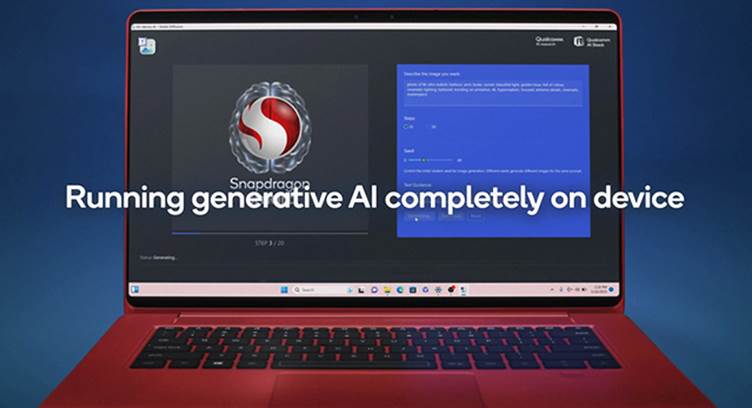During Microsoft Build 2023, Qualcomm Technologies, Inc. displayed its latest innovations in on-device AI, including showing generative AI running on Snapdragon® compute platforms, as well as new pathways for developers building applications for Windows 11 PCs powered by Snapdragon.
The future of AI needs to include both on-device and cloud AI. Running AI applications on device improves cost effectiveness, privacy, personalization, and latency. Snapdragon platforms include a dedicated Qualcomm® AI Engine to process AI workloads more efficiently than when processed purely on CPU or GPU, making on-device AI possible even in small, thin, and light devices.
At Microsoft Build, Qualcomm Technologies will show demos and offer tools to help develop generative AI on the next generation of Windows 11 PCs. Stable Diffusion, a text-to-image generative AI model with more than 1 billion parameters, now runs entirely on the device, and the Company says it sees a clear path to running models with up to 10 billion parameters on devices in the coming months, including large language models (LLMs). To enhance the Qualcomm® AI Stack and help developers create the next generation of on-device AI experiences, the Qualcomm AI Engine Direct SDK will be made available to the public for the first time at Build. With the ONNX Runtime and Qualcomm AI Stack, you can run your AI workloads today on the Snapdragon 8cx Gen 3 AI Engine on both the Surface Pro 9 5G and Lenovo ThinkPad x13s.
Qualcomm Technologies will also show at Build the dramatic performance improvements available when popular applications are compiled natively for Snapdragon, as well as debut a new developer portal which collects critical tools, resources and support for Windows on Snapdragon development in one easy-to-use location.
Ziad Asghar, senior vice president of product management, Qualcomm Technologies, Inc
For generative AI to become truly mainstream, much of the inferencing will need to be executed on edge devices. Our best-in-class AI hardware and software empowers developers to make full use of our powerful AI capabilities, delivering incredible new user experiences on laptops, phones and other devices powered by Snapdragon.
Pavan Davuluri, Corporate VP, Windows Silicon and System Integration at Microsoft
Both cloud and device processing are needed to extend AI across the vast universe of devices and applications. By bringing together Microsoft’s cloud AI leadership and the capabilities of the Windows platform with Qualcomm Technologies’ on-device AI expertise, we will accelerate the opportunities for generative AI experiences.






















